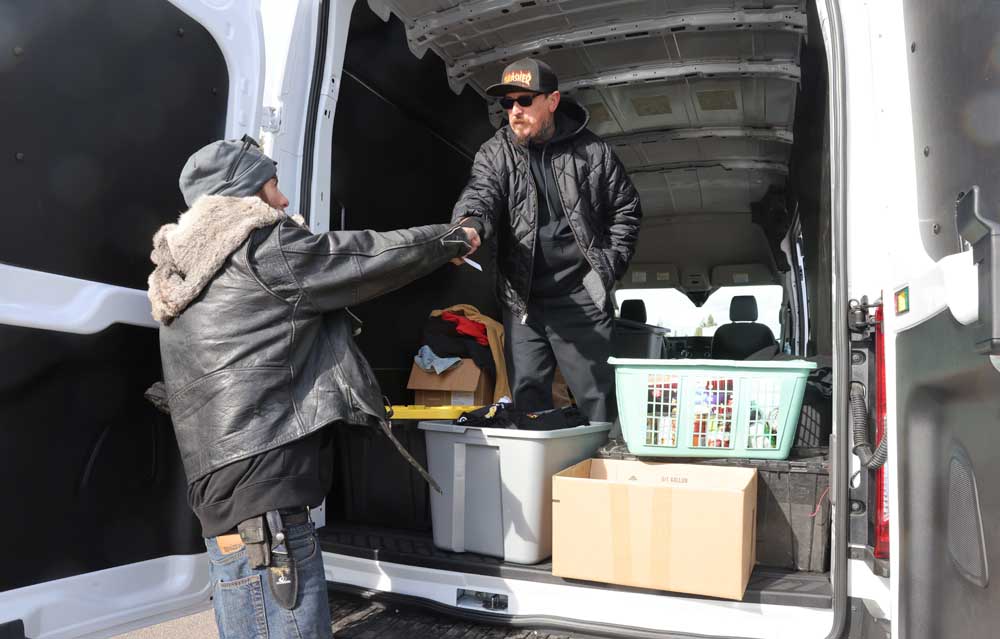Outreach efforts will play a central role in expanded addiction treatment programs
Published 2:30 am Sunday, November 13, 2022

- BestCare Community Engagement Team Care Manager Barrett Hamilton, right, works with Wiley Dave during outreach on Hunnell Road in Bend in early November.
BestCare, which has provided drug addiction treatment in the region since 1997, is set to receive the largest share of the more than $15 million distributed to Central Oregon under Measure 110 for addiction services. That’s about $5.5 million for Deschutes County, plus another $2 million for services in Jefferson County and $1.5 million for Crook County.
Barrett Hamilton is leading one of BestCare’s biggest Measure 110 endeavors: A new Bend “engagement center,” where people with addiction can get assistance with whatever they need to stay safe, from basic needs to employment assistance, to rapid access to BestCare’s outpatient addiction treatment services right across the hall.
Prior to the Measure 110 expansion, Hamilton offered similar services out of a van in Redmond.
“This will be a bigger version of that,” Hamilton said. “This will be a place they can come, and we’ll just try to remove the barriers that are keeping them stuck in their addiction and when they
realize ‘OK, I need detox or I need treatment or I need mental health,’ we can act right then.”
The idea of relying on outreach and engagement to get people into treatment rather than law enforcement or punishment appeals to Hamilton’s own path to addiction recovery.
“I was in active addiction for 27 years. I’ve been in jail, in prison, and it never stopped me,” Hamilton said. “But what has worked in those 27 years: I was sober two different times. … both times I went to treatment and figured it out. This time I didn’t make the same mistakes I made last time.”
BestCare has some experience offering people with addiction a range of services in hopes of helping them on the path to recovery. The organization has operated an engagement team in St. Charles hospitals’ emergency floors for a little over two years.
The premise of that work is fairly simple: Hospital social workers call the BestCare team whenever someone comes into the emergency room with a drug- or alcohol-related issue. An engagement team staff member meets the individual at their bedside and walks through what the person might need.
One learning curve of operating that program is defining what “success” looks like for an individual client, according to Kristina Van Alstine, the program’s case manager. While people might not initially want to get into addiction treatment, the outreach efforts build connections so those people have resources to do so if they wish, she said.
“I think, if people can get away from the black and white thinking of what behavioral health is and look at the gray and see that it’s not the same for everybody, I think that maybe we will have success in taking care of the substance use epidemic,” a Alstine said.
Since it started, the engagement team has seen about 600 people in the emergency room, Van Alstine said. A little over half of those had some kind of further relationship with the BestCare team. For some, that was as simple as follow-up phone calls or peer support meetings. For about 9% of those who engaged, that was a connection to medication supported recovery services, 16% received access to detox services, and about 37% received some kind of substance use treatment.
For BestCare Executive Director Rick Treleaven, the project of Measure 110 is a statewide “social experiment” in pivoting from a historically criminal-justice-oriented response to addiction.
“And so we’re going to stop that, and we’re going to set up a system of engagement and outreach and harm reduction to that population with the hopes of decreasing the damage of drugs and alcohol and hopefully engaging a certain percentage of those people into recovery-based services,” Treleaven said.






